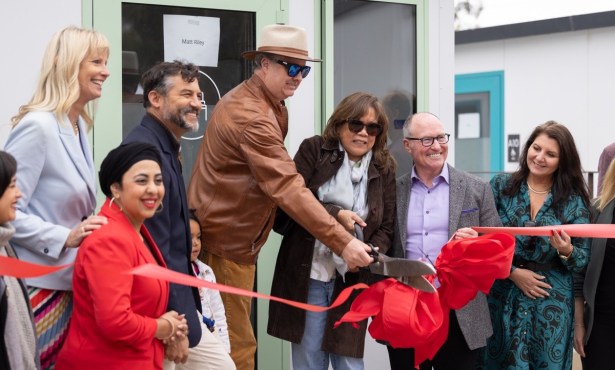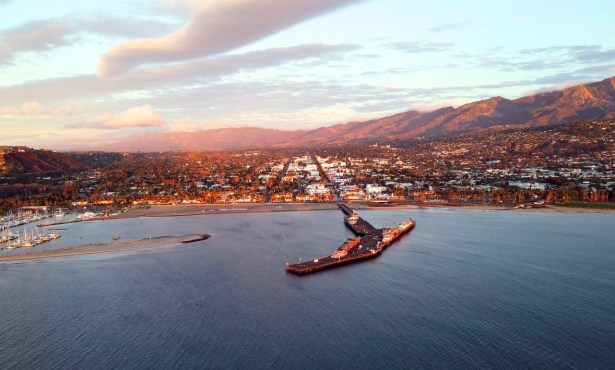No Moratorium
Water Boss to Populace: Stay the Course

On paper, it seemed like a bold response to the hottest, driest drought in the past 100 years: In reality, Santa Barbara City Hall won’t be asking residents to conserve any more water than they already are. This Tuesday, the Santa Barbara City Council unanimously agreed to ratchet up its current water conservation goal from 25 percent to 35. That appears more dramatic than it is. In the past year, city residents have cut back water use by 34 percent. In recent months, they’ve hit or exceeded the 40 percent mark. “We’re not asking anyone to take it up a notch; we’re not raising the bar,” said city water czar Joshua Haggmark. “I want you to keep doing what you’re doing.” City residential water users consume just 52 gallons a day, Haggmark noted. The statewide standard for basic health and safety considerations is 55. In a typical year city water customers use 14,000 acre-feet a year; this year it’s down to 10,000 acre-feet.
This public-policy punch line to all these impressive factoids — the last five years have been 12 inches drier than the previous driest five-year span in 97 years — is that city water customers do not need the boot heel of any new prohibitions to go the extra mile. For City Hall to adopt a more coercive approach, Haggmark argued, is not called for. If all the proposed development plans now in City Hall’s permit-and-review pipeline were nixed overnight because of the drought, city planner Allison DeBusk said, only 242 acre-feet of water would be saved. That’s just 2.5 percent of the city’s water supply. But Councilmember Jason Dominguez expressed concern that the number of new development applications is growing — particular high-density apartment applications that rely on more liberal zoning rules designed to encourage developers. That 2.5 percent, he said, is not inconsequential and, if not watched carefully, could easily balloon to 10 percent. Dominguez noted that Montecito and Goleta have passed moratoriums on new development in response to the drought; the City of Santa Barbara, he said, “subsidized” for-profit development. Dominguez did not advocate, however, any new prohibitions.
Haggmark also briefed the council about efforts by the Montecito Water District to buy water from the city when its refurbished desalination plant becomes operational this fall. Montecito, with some of the shallowest groundwater basins and the thirstiest, wealthiest customers, is in dire need of new water supplies. With this year’s El Niño rain a no-show, Montecito’s interest in acquiring Santa Barbara’s water has intensified. While those efforts have generated a few buds, no fruit has sprouted yet. At this point, there’s only a back-of-the-napkin menu of agreed-upon items: Montecito will buy 1,250 acre-feet a year — for the next 20 years — come rain or drought. (City Hall had planned to operate the desalination plant at a 3,125 acre-feet production capacity; should the deal go through, that amount would increase.) Montecito would cover 40 percent of the $55 million it will cost to build the desal plant, and it would pay 30 percent of the annual operating costs. Likewise, Montecito will be on the hook for building the 15,000-foot — or nearly three-mile — pipeline from the desal plant to Barker Pass and ultimately into the South Coast Conduit on Highway 192, which takes water from Lake Cachuma to all the South County water districts. That pipeline could prove crucial to any distribution system serving new water technologies as yet unperfected. Councilmember Gregg Hart urged city water planners to make sure parallel pipeline capacity for recycled wastewater was included in any trenching work done for the pipeline connecting the desal water to the South Coast Conduit. No state regulations exist as yet for this highly treated recycled water, but with millions of gallons a day being flushed into the ocean, its supply potential is obvious.
Councilmember Cathy Murillo expressed doubts about any deal with Montecito, citing populist and environmental grounds. She expressed concern about the loss of microscopic aquatic life the desal plant’s intake pipes would inflict below the surface; likewise she said her constituents on the Westside would want to know “what kind of lifestyle is [the water] supporting?”
It was Mayor Helene Schneider, however, who identified both the banana peel and slippery slope that any deal with Montecito made manifest. Operating one desal plant along the coast, Schneider said, made far more sense than two. But it was also city policy, she noted, to activate the desal plant only as a temporary and emergency fix and not as part of the city’s ongoing water-supply portfolio. To operate the plant full-time for Montecito, she suggested, was a deviation from that policy. Desal, she said, is mentioned in every water department planning report, adding, “It’s not a long-term water supply.”


